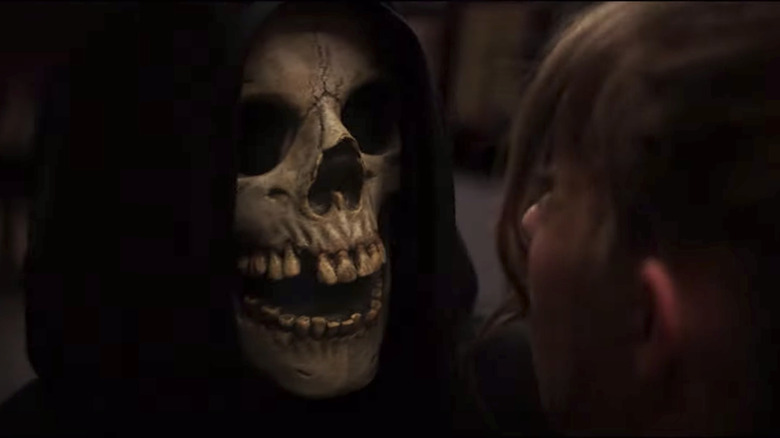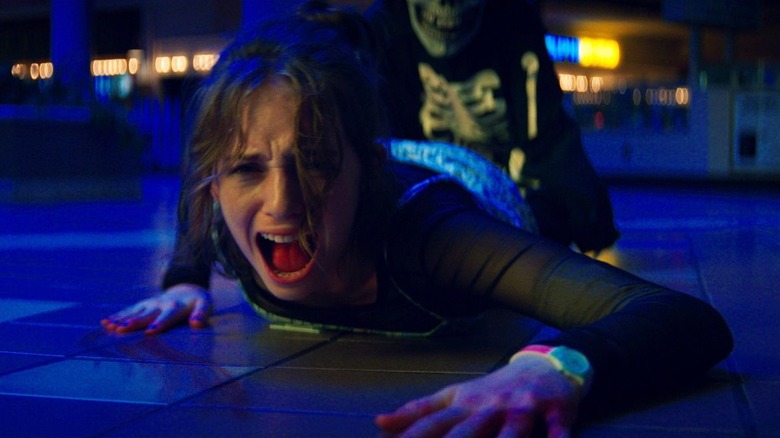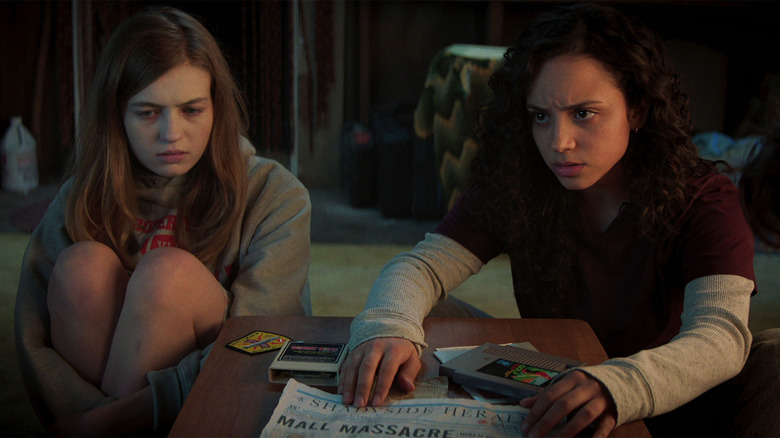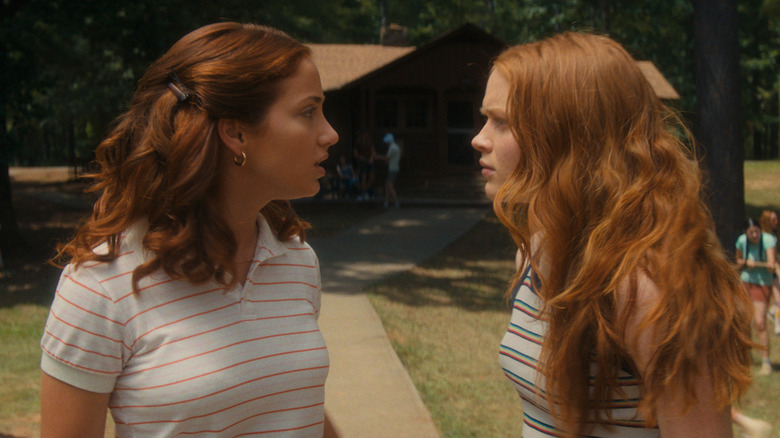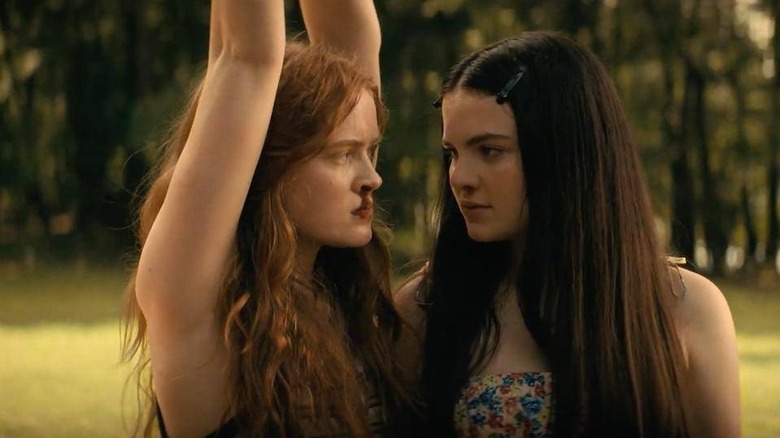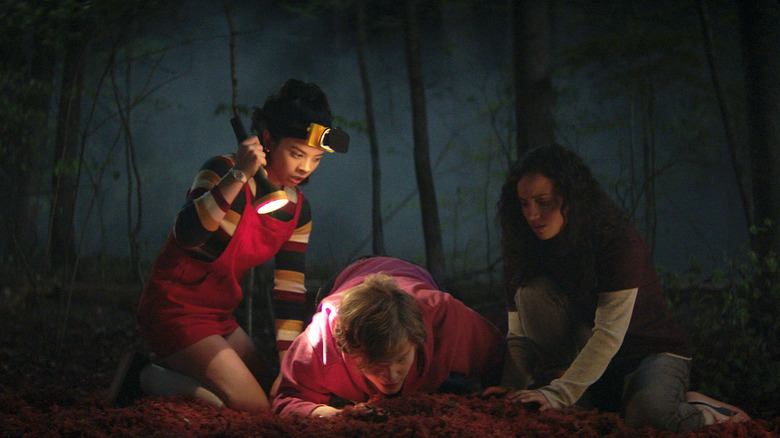The Untold Truth Of The Fear Street Trilogy
Author R.L. Stine is probably best known for his kid-friendly horror series — "Goosebumps." Stine managed to find ways to keep children awake at night with pretty much anything you can imagine, from scary puppets to haunted masks. What people may not know is that "Goosebumps" technically wasn't Stine's first horror series.
While the first "Goosebumps" book came out in 1992, "Fear Street" debuted a full three years earlier with scarier themes and actual bloodshed. "Goosebumps" may have dominated middle school libraries, but "Fear Street" proved R.L. Stine could give Stephen King a run for his money. Now, the series has its time in the sun thanks to a whole trilogy come courtesy of Netflix.
It all began with "Fear Street Part One: 1994," which was released on July 2, with the other two installments coming out one week after the next. It's an ambitious release strategy, but it tells a sinisterly chilling story with all three combined. There's quite a bit you may not have noticed about these movies, so here are some fun facts to impress all of your friends.
Fear Street was born out of spite
You might think R.L. Stine had some grand vision about scaring teenagers, but in actuality, the "Fear Street" books and movies only exist because R.L. Stine's editor friend gave him the idea. In 2013, Stine sat down for an interview with NPR, where he began discussing his evolution into horror. He mentions how one day in the 1980s, he had lunch with a friend who worked with another horror author — Christopher Pike. According to the story, Pike did something that upset the editor, so they gave Stine a challenge: "I'll bet you could write good horror. Go home and write a novel for teenagers. Call it 'Blind Date.'"
Stine went home and wrote precisely that. The novel did exceptionally well, and it showed Stine that perhaps he could have a career in the genre. Stine followed up that novel with one called "Twisted." These books weren't technically part of the "Fear Street" series, but they showed the author that kids wanted to be scared, and it wasn't long until "Fear Street" came to life.
Fear Street Part One: 1994 has a sneaky shoutout to R.L. Stine
The opening sequence of "Fear Street Part One: 1994" takes a few cues from "Scream." It focuses on a recognizable star, namely Maya Hawke, whom you would expect to lead such a film series. However, she ends up being the first victim, getting slaughtered by the ancient evil force at work in the town of Shadyside. However, before her quick demise, there's a fun Easter egg that gives the author of the "Fear Street" books a proper reference.
As the camera scrolls through the bookstore where Hawke's character works, you can see several horror novels written by someone called "Robert Lawrence." It might be easy to think this was just a random name or perhaps the name of whoever was the assistant editor on the movie; it's actually the first and middle name of "R.L. Stine." On top of that, the titles of the books — "The Surprise Party" and "The Wrong Number" — come from actual "Fear Street" novels.
There are some musical anachronisms
"Fear Street Part One: 1994" takes place in ... well, 1994. It's right there in the name. And it has an appropriately grungy soundtrack to accompany all of the murders. From Soundgarden to Nine Inch Nails, there are plenty of tracks to make you feel like a member of Gen X. While all of the bands featured indeed represent the 1990s in general, there are a few that don't quite fit with the whole "1994" aspect of the film.
Shirley Manson and the rest of Garbage embody the angst everyone felt in the '90s. Their most famous song, "Only Happy When It Rains," certainly fits the vibe of "Fear Street," but that song didn't come out until 1995 when the band released their self-titled debut album. "More Human Than Human" by Rob Zombie came out that same year.
Other inconsistencies include "Machine Head" by Bush and "Your Woman" by White Town, which came out in 1996 and 1997, respectively. However, we're guessing most people just go with the vibes of the songs and don't do intensive research like us.
Fear Street Part Two: 1978 has a ton of David Bowie references
Music seems to have played an influential role in the "Fear Street" movies. Not only does the "1994" soundtrack have one grunge banger after the next, but "Fear Street Part Two: 1978" keeps the good times rolling by referencing David Bowie ad nauseam.
The first time occurs when we see a label for "The Man Who Sold the World." While the song was initially written and performed by David Bowie, the version that plays in the movie is the cover by Nirvana. Shortly after that, the audience meets C. Berman's (Gillian Jacobs) dog named Major Tom. This is an obvious nod to the astronaut mentioned in the song "Space Oddity."
There's also Ziggy Berman (Sadie Sink). Her name is an allusion to Ziggy Stardust, the on-stage persona Bowie adopted from 1972 to 1973. Even if you're not into horror, the soundtracks alone for these movies make them worth a watch.
The Fear Street movies filmed out of order
Before cameras even started rolling, the "Fear Street" trilogy was always going to be an ambitious project. The original plan was for the three movies to come out in theaters one month after the next. As a result of the COVID-19 pandemic, that strategy had to be scrapped, and the trifecta made its way directly to Netflix (via GQ). While each installment releases on July 2, 9, and 16, respectively, the actual productions of the films got a little wonky at one point.
Filming on "Fear Street Part One: 1994" began in March 2019 (via Deadline). The final film to finish production was actually "1978," which wrapped in September (via Atlanta Magazine). The schedule ended up not making much of a difference, seeing how all three movies were delayed from the pandemic, so there was plenty of time to edit and finish them up before their Netflix releases. With these fun facts in hand, you can go back to watch the entire triumvirate with newfound appreciation.
